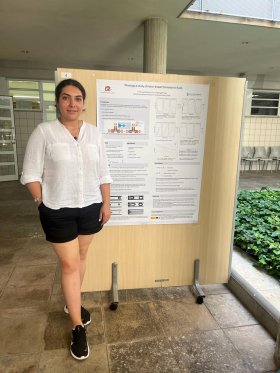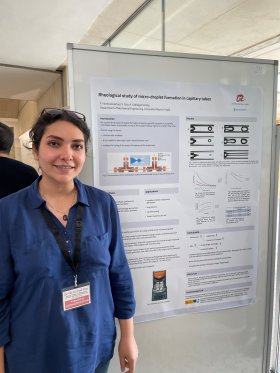Farnoosh Hormozinezhad


PhD Programme: Nanoscience, Materials and Chemical Engineering
Research group: ECoMMFiT - Experiments, Computation and Modelization in Fluid Mechanics and Turbulence
Supervisors: Salvatore Cito & Alexandre Fabregat Tomàs
Bio
Farnoosh pursued her MSc degrees in Polymer Engineering, at Iran Polymer and Petrochemical Institute (IPPI), Tehran, Iran in 2020. She also obtained her Bachelor of Polymer Engineering degree in the field plastics. She has immense research interest in biofluids, multiphase flow, viscoelasticity, viscoplasticity, and data processsing. She has practical skills on rheology, mechanical, and thermal characterization of materials. Prior to joining the programme, she was working as as lab expert at IPPI for one year.
Project: Rheological study of droplet formation in biofluids
It is well known that droplet formation is influenced by both the physical properties of the ejected fluid (surface tension, viscosity and density) and the flow conditions characterized by a length l and a velocity u scales. The amplitude of the pulse applied on the fluid also influences the jetting by modifying the fluid velocity of the droplet outside the microdispencer. From dimensional analysis, the Reynolds number Re, which represent the ratio of the inertia to viscous force, the Weber number We, which represent the ratio of the inertia to surface tension force, and the Ohnesorge number Oh = We/Re, which represents the ratio of viscous to surface tension forces and which is independent of the droplet velocity, have been found to control the droplet formation process. Theoretical studies indicate that stable droplet formation can occur for La > 2 where La = 1/Oh is the Laplace number defined as the inverse of the Ohnesorge number. Computational and experimental study about the DOD drop formation also showed that a printable fluid should obey 1 < La < 10. The lowest value of Z is governed by the dissipation of the pressure wave by the viscosity of the fluid whereas the higher limit is determined by the fact that the fluid forms satellites droplet instead of a unique droplet. These studies of drop-on-demand jetting have only considered Newtonian fluids, however, it has been established that viscoelasticity can strongly influence droplet velocity and droplet volume. Fluid linear viscosity can be represented in term of a complex viscosity η* = (G' + iG'')/ω where G' is the elastic modulus and G'' is the loss modulus. Previous work has shown that drop-on-demand dispensed fluids can be characterised using G' and G'' data, however, the short relaxation times involved with drop-on-demand fluids require special experimental techniques to be adopted. In this thesis we aim at studying the way linear and nonlinear viscoelastic properties of the fluids affect the filament breakdown and droplet formation mechanism.
Outreach activities
- European Researchers’ Night 2021: "Lava lamps".
- International Day of Women and Girls in Science 2023: Interview for the institutional video on social networks.
- European Researchers' Night 2023: "Parc de Fluídica".



